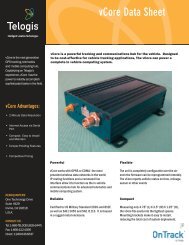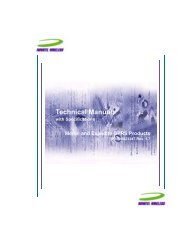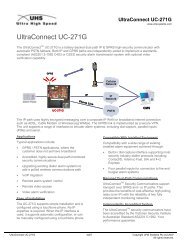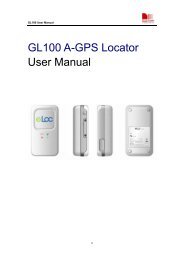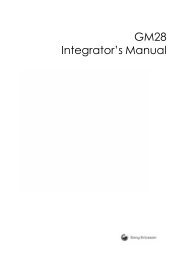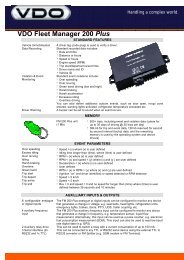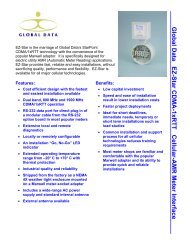Hardware Interface Description - KORE Telematics
Hardware Interface Description - KORE Telematics
Hardware Interface Description - KORE Telematics
Create successful ePaper yourself
Turn your PDF publications into a flip-book with our unique Google optimized e-Paper software.
XT55/56 <strong>Hardware</strong> <strong>Interface</strong> <strong>Description</strong><br />
Confidential / Released<br />
s<br />
4 GPS application interface<br />
The XT55/56 module integrates a GPS receiver which offers the full performance of GPS<br />
technology. The GPS receiver continuously tracks all satellites in view, thus providing<br />
accurate satellite position data.<br />
The GPS block can be used even if the XT55/56 module is deregistered from the GSM<br />
network.<br />
4.1 Theory of operation<br />
Figure 26: Theory of operation<br />
The XT55/56 GPS part is designed to use L1 Frequency (C/A Code) GPS receiver and<br />
performs the entire GPS signal processing, from antenna input to serial position data output.<br />
The processing steps involved are:<br />
• RF section<br />
In the RF section the GPS signal detected by the antenna is amplified, filtered and<br />
converted to an intermediate frequency (IF). An A/D converter transforms the analogue<br />
intermediate frequency into a digital IF signal.<br />
• GPS channels<br />
The received digital IF signal bit stream is passed to the baseband section, where it is fed<br />
into the correlators. The function of the correlators is to acquire and track the satellite<br />
signals. There are 12 channels used in parallel, with each correlator looking for a<br />
characteristic PRN code sequence in the bit stream. Once the correlator has found a<br />
valid signal, pseudo range, carrier phase and orbit information can be extracted from the<br />
GPS signal.<br />
• Navigation<br />
The on-board processor is running an algorithm that calculates the position, velocity and<br />
time. This calculation is called navigation solution. Once the navigation solution is<br />
calculated, it can be transformed into the desired coordinate system, e.g. Latitude/<br />
Longitude/ Altitude. For further details refer to [3].<br />
• <strong>Interface</strong><br />
The data of the navigation solution are available at the serial RS-232 interface.<br />
XT55/56_hd_v02.06a Page 70 of 125 17.12.2004



